Witches Falls Cottages
Relax, Rejuvenate & Reconnect...
Walk To A Waterfall - Map Guide
Self Guided Walk Through Joalah National Park, Tamborine Mountain
This small but interesting park, which was declared a national park in 1927, was originally partly cleared by early timber getters in the 1800's. Fortunately many fine species were spared.
A water wheel powered sawmill was constructed by the Curtis brothers on the stream above Curtis Falls and later Tom McDonnell’s steam powered mill went in much further downstream. Both of these were abandoned many years ago and the rainforest has overgrown any traces.
The park now contains a great range of the typical flora and fauna of Tamborine Mountain.
The Map Guide below will help you to identify and appreciate the many species that abound here. As you pass each post numbered 1 to 20, pause and note the descriptions shown on the Map Guide.
Please do not touch any of the plants, it is not good for them and some may sting you (seriously).
Walk to a Waterfall and discover a LOT of nature (allow about an hour - about 1.5 kilometer return).
There are many waterfalls on Tamborine Mountain, but Curtis Falls waterfall is the most famous of them all and very accessible to all fitness levels.
The Map Guide below has been created as an interactive map that you can have fun with by selecting different items of interest
--- just try clicking on any point of interest or number --- give it a go you might be surprised!
If you would like to view a non interactive version or to print out the map below as a PDF, please CLICK HERE.

Google Map Directions

This map describes the self guided walk through Joalah National Park starting at Curtis Falls corner on Eagle Heights Road. You find the trail entrance to the right of the Tamborine Mountain Map Sign Board.
This link to Google Maps will lead you there and we have used Curtis Falls Cafe as the marker. There is a public car park across the road from Curtis Falls Cafe in front of Tall Trees Motel.
Additional Parking is available if you follow Eagle Heights Road towards Gallery Walk and turn into Dapsang Road just after the Church. You will find generous parking facilities as well as public toilets at this entrance to Joalah National Park.
Post 1
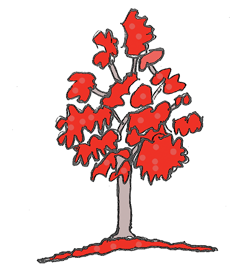
Entering the Park at Curtis Falls corner on Eagle Heights Road you will cross a small timer bridge with large Flooded Gums (E. grandis) on either side.

Over hanging the bridge is a Sand Paper Fig with its rough hairy leaves. Next to the left is a large Syzygium crebrinerve, or Purple Cherry, with a vine covered trunk, the lower vine being a Pothos longipes, and the upper is a Pepper Vine. In late summer a carpet of fallen yellow fruit will cover the ground from one of the vines on this tree.
To the right are some Walking Stick Palms, a low palm with bright red berries in season. These are next to a large Black Bean tree with a Churnwood in front, which is covered by Lawyer vine and a Pothos vine.
On the left is our first stop, Post 1.
Behind this is a large Strangler Fig, Ficus watkinsiana, and to the right are more Walking Stick Palms and a Pothos longipes vine enwrapping a large Brachychiton, Illawarra Flame Tree.
A taller tree next along is a Churnwood. Behind the post is another Purple Cherry. You will see quite a few of these Syzygiums through the park with their reddish purple fruit strewing the ground through summer.
Post 2
Post 2 is now on our left with more Walking Stick palms and another large Purple Cherry with its pale bark, while opposite is a large Red Carabeen. This shows heavy scarring from an old vine.
Past it is an unusual thicket of cane like vines. This is Flagellaria indica, whose name is derived from the Latin meaning to whip or cane.
Behind the Indica is a tall Rosewood which will strew the ground with its fruit from late summer to early winter. These fruits are an important food source for the larger birds.
Post 3
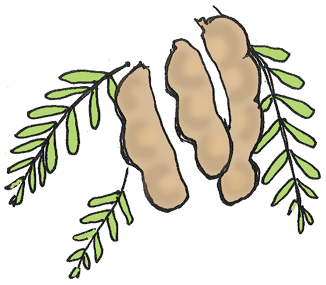
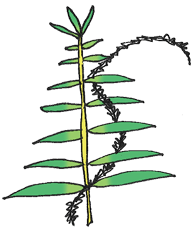
We now come up to Post 3.
The large tree on the right is a Red Bean and to the left of the path are more Strangler Figs, which are slowly covering the host tree that will eventually die.
Close behind the post is a small Green Tamarind.
Further to the right is Lawyer vine, commonly known as Wait-a-while plant in the rainforest.
Further back from the path to the right a giant Strangler Fig with a precarious lean, but its strong buttress roots will support it.
The canopy is now becoming less dense allowing in more sunlight to aid the growth of younger trees.
Post 4
Passing Post 4 you see a large Black Bean to the right and a very large vine, possibly a Pepper vine, climbing a Syzygium and a Churnwood alongside. Look at the thickness of the vine, it is very old.
Opposite the post is another Purple cherry and a Giant Stinging Tree which is similar to the Gympie Gympie Stinging Tree found in other parts of the state. This also has the ability to deliver an extremely painful and long lasting sting if its large round leaf is touched, even when lying dead on the ground (don't be tempted!) Mountain Bushtail possums however appear immune to the danger as their marks are often left on the trunks as they climb to eat the fresh shoots.
Next on the left is a fallen tree that has been caught by another. This tree, a Thorny Yellowwood, has broken under the weight. The trunk is still standing and will shoot again. The fallen trunk is quite thorny to the touch. Quite a few trees have been brought down by this fall.
A little further are two young Native Olives, one growing in the middle of the path.
Post 5


Many Species can be seen opposite Post 5 including Walking Stick palms, Supplejack vine and another Purple Cherry and a White Booyong.
The large tree is possibly a Marara and further is a clearer area of understory plants, hosting many birds including White Browed Scrubwrens, Pale Yellow Robins, Small Thornbills and many more.
A young Native Wisteria is growing in this clearing.
On the left of the path is a plant that looks like a type of lily. This is the Cunjevoi plant, which is common through the rainforest. This plant was important to the Aboriginal people for its medicinal value.
Here are also some young vines reaching up to flower at the canopy. This is Pararistolochia praevenosa, also known as the native Dutchman’s Pipe, and will host the larvae of our beautiful and endangered Richmond Birdwing butterfly.
A little further are several small thorny shrubs, Citrus australasica, the native Finger Lime.
On the right near the rear of the clearing is a tall Rosewood and a tall Pencil Cedar also on the right.
Watch a Pale Yellow Robin enjoying his bath...
Post 6
At Post 6 to your left are a Green Tamarind, a small Green Bollygum, and more Finger Limes.
To the right is a tangle of Lawyer vine.
Opposite the post, the small tree is a Pink Lace Flower.
Also on the left alongside the path is a group of young trees including Maiden’s Blush, Native Tamarind, White Tamarind with larger leaves, a Hairy Supplejack vine and many others including Turnipwood, White Boolygum, a Brush Pepperbush and an Illawarra Flame Tree.
Under these are some shield ferns. There are often small birds also here.
Opposite is a Red Kamala and a Red Bean tree.
Post 7
Near Post 7 are more low shield ferns and a White Bollygum (Neolitsea dealbata).
Also here to the left are Maidens Blush, a small Bolwarra, Bleeding Heart, which is a smaller under story tree that grows profusely in clearings and a small Turnipwood.
A larger tree, White Acronychia, over hanging the path has Red Mistletoe growing on its branches.
Opposite is a Hairy Rosewood that may be fruiting in late Autumn.
Post 8
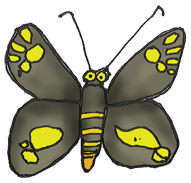

To the right, behind Post 8, is a young Booyong and an Illawarra Flame Tree.
Just prior to this can be seen a small Wilkea austroqueenslandica shrub with its broad leaf as well as the ordinary Wilkea shrub. This vine is host to the larvae of one of the prettiest of Australian butterflies, the Regent Skipper.
At this point the path meets the entry from Dapsang Drive car park. To the left of this entry (on entering), are Bleeding Heart, White Bollygum, a small White Beech and a larger Yellow Kamala. To the right of the entry are Wilkeas and White Bollygum. A Green Bollygum overhangs the path at this entry.

From here on the taller trees such as Flooded Gums, giant Strangler Figs and Brush Boxes will be seen through more open forest.
You may also hear the higher dwelling birds such as Fruit Doves, Wompoos, Pigeons, Bower Birds and Cat Birds.
A male Albert’s Lyrebird has his calling territory in Joalah and you may be lucky enough to hear or sight it. This rare bird is found only in the ranges from Lamington to Tamborine Mountain.
The Brush Turkey is common here and can be easily confused with the Lyrebird.
Listen to the amazing sounds the Lyrebirds are able to create!
Post 9
Walking into this section of the park you will see a large Black Bean to the left and a White Booyong on the right with its spreading buttress system.
Some way further to the left a Black Bean with a multi-forked trunk and some Flooded Gums, before arriving at Post 9. Here the Moreton Bay Fig, Ficus macrophylla, opposite has a large unusual buttress root formation and appears to have grown from a ground sown seed and not in a host tree’s canopy due to the smooth straight trunk.
Further to the left high on a Celerywood are many fine epiphytes, Orchids, Elkhorns and Staghorns.
To the right alongside the path for some way can be seen many shield ferns and a ground cover of Aneilema (native Wandering Jew).
Also on the right is a small Shiny Leaf Stinger, which will also give a nasty sting. So do not touch.
Post 10
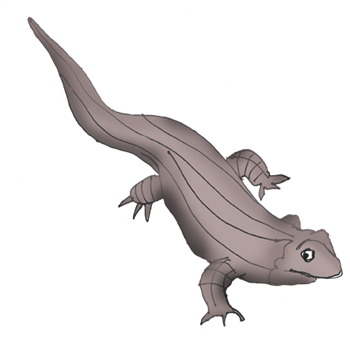
You are now passing a fallen trunk that has been sawn through for path access, just before Post 10.
This area may have ground dwelling birds such as Log Runners, small Thornbills and a Whipbird calling, as well as a large skink that sometimes resembles a black snake when it is partially covered.
This is the Land Mullet, which likes to sunbake on the leaf litter and may be seen near here to the right. The local name for it is Sleepy Jack, due to its habit of seemingly ignoring passers-by while it dozes. It may have a nest below this leaf litter.
On the right is native Lobelia, a small ground cover with blue flowers.
On the left behind the post is a large dead Flooded Gum trunk with a good burl. These dead trunks provide fine nesting hollows for many creatures including parrots and possums and are an important part of the forest.
Land Mullet sunning himself in the garden at Witches Falls Cottages...

Post 11
Opposite Post 11 is a large Crows Ash, Flindersia australis, and behind that is a tall Brush Box with a fine native Cymbidium orchid well up.
A little further past the post is a large mound, built by the male Brush Turkey for the female to deposit her eggs.
More ferns can also be seen as well as some native Finger Lime bushes on either side of the track.
A sawn log seat is provided here for the walkers rest. A tangle of Lawyer vine (Wait a while) is behind the seat and beyond it is an old Brush Box.
Another large dead gum had a good burl on its side next to the left.
Further on to the right are some very thorny larger native finger lime bushes.
Post 12
Beside Post 12 is a tall Blue Quandong and opposite is more Lawyer vine and many young saplings ready to grow to the canopy, also a large leaf vine, Parsonia fulva.
Behind the post is a native grape vine.
Next along are some very large and old Brush Box trees, some having Box Orchids growing on the trunk.
Post 13
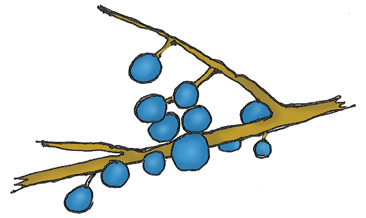
On a sharp bend in the path before Post 13 to the right is a very good small bird area with some good young tree species including Tamarind and Blue Quandong.
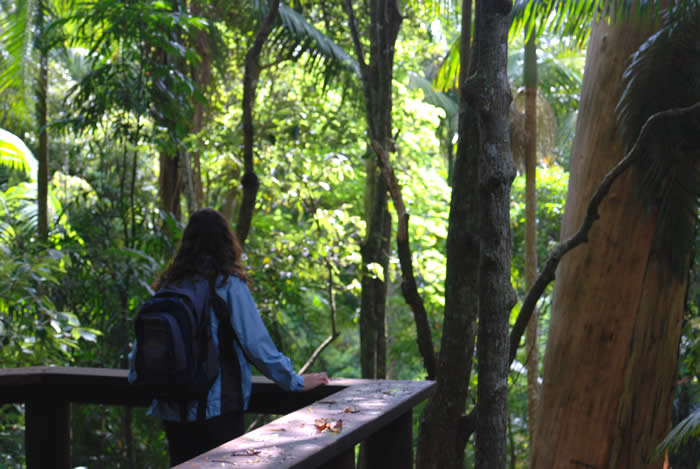
To the right is a tangle of Lawyer vine and some Cordyline and to the left are a couple of Bollygum trees, Litsea reticulate.
Down the slope to the right is a grove of tall trees bearing bright red fruit, these are Red Apples, Syzygium ingens.
The path passes between two giants of the forest, a Brush Box to the right and a Flooded Gum (E. grandis) on the left. This tree has a large root burl that has grown over another old stump. Look inside to see where many forest creatures would gain good shelter.
Behind this giant are a few of its cousins towering above the canopy.
The track here has a short detour to the left to a fine viewing platform where many birds may be heard and seen.
On the left of this short path is a Tree of Life (Lignum vitae), which is just alongside the platform step, and a thorny shrub, Cockspur, beside it and a Scentless Rosewood with the rougher bark, just behind it.
Opposite is a young Hairy Walnut, while around the platform are seen a large Red Carabeen, some small Bollygums and Bolwarras and a find Strangler Fig.
The large dead tree was a giant Flooded Gum.
Post 14
Taking some steps to Post 14 a large Black Booyong has been hollowed at the bottom, possibly by fire caused by a lightening strike, showing the inner wood. The tree is however quite healthy.
Opposite is Cockspur, a Finger Lime and two types of Cordyline, (congester and petiolaris) in front.
On the way down more steps, look to your left to see a very tall tree, this is a Rosewood, notice the fine deep green foliage at the crown high above.
Post 15
We now pass Post 15 with two large Syzygium, Purple Cherry, on either side and further on the right is a large Yellow Carabeen with good convex buttress.
Here you will see where the slope is gradually eroding toward the creek as the stream widens the gorge over the centuries.
Large holes may be noticed where old trees have fallen with the root system taking the hillside away. A way further down to the right you will see such a tree that been uprooted, look at the immense root bowl.
The palms are now denser, taking advantage of the moist run off.
Post 16

Near Post 16 are few larger Strangler figs, F. watkinsiana, and opposite is a large Red Carabeen.
The Fig just past this on the right has good Crows Nest Ferns high up.
More steps down with a Red Crarabeen to the right and good epiphytes on the fig to the right, which is slowly strangling the host Syzygium.
We are now at the creek track with the falls path to the left. The following will describe this pathway to the falls.
To the right is Cedar Creek tumbling down the small gorge and to the left is a Red Kamala overhanging the path. There is some native ginger plant here on the bank and ground cover Aneilema.
Post 17 - Curtis Falls

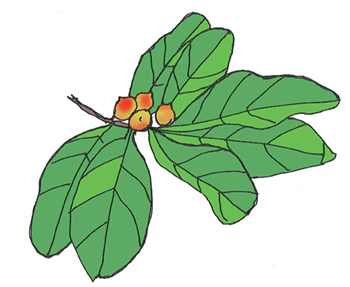
We now approach the Curtis Falls viewing platform where the large rock pool is teeming with life.
The cliff face to the left from the falls to the platform is the remnant basalt from the Mt Warning volcanic flow. When this cooled around two million years ago it formed the basalt columns that you can see here in the rock face.
A large piece of column has dislodged and fallen and is now lying alongside the platform steps. This is sometimes referred to as chimney pipe formation.
The rock face is also home to many glow worms. These cannot be seen in daylight hours but will provide a magnificent night display. Negotiating this path at night is dangerous and advice should be first sought.
Southern Cross 4WD Tours offers a Guided Rainforest Night Walk for guests staying at Witches Falls Cottages for $35 per person. This includes transfer from and to your cottage, a guided Night Walk through Joalah National Park including the Glow Worms at Curtis Falls and a refreshment of Coffee and Cake at a local restaurant.
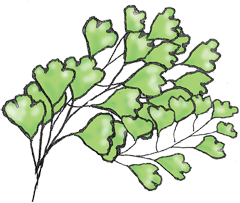
The rocks are also covered by vines, Arhropteris and Pepper vine, and Maidenhair ferns.
The large unusual tree beside the platform is actually three, an old Stinging tree with two other trees intertwined from the roots. The large round leaves on the ground are from the stinger and will inflict a painful sting if touched.
A small Sandpiper Fig is just behind the fallen rock column.
Post 18
By now following the lower path alongside the creek, where you may spot a Water Dragon scurrying across the path, also watch for the elusive Albert’s Lyrebird.
Next you will come to a bridge where on the other side is Post 18.
The stream has great variety of water life of small native fish, eels and crayfish. Water boatmen may be seen on the stream’s surface.
The rocks and banks are home to many species of frogs including the Stony Creek frog, which may often be heard. This frog always dwells near running water.
Around this point are many fine rainforest species such as Maidens Blush and the fig near Post 18 showing good lacework as it clings to its host.
Further along the track and set well back on the left is a fine Black Booyong with its very dark trunk, and further still is a Red Carabeen.
Post 17
At Post 17 we see large rocks that have tumbled to here as the bank erodes.
The area here has been cleared by tree falls and the abundant regrowth includes young stinging trees, native olive, bleeding heart, and opposite is a large fig covered in vines such as Pothos, Native Wisteria and epiphytes.
Above the bank is a Black Apple, Pouteria, whose large black apple like fruit was sought after by the Aboriginal people.
Around here are quite a few small and large Red Carabeens on either side, a Brush Alder on the right and a vine laden Purple Cherry and a small Native Gardenia to the left and a small Native Olive.
The ground cover with the long runners is Pollia.
Stay at Amore B&B - great accommodation in a central position
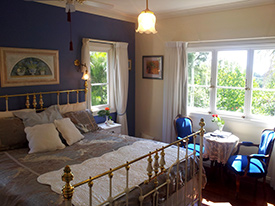 Amore B&B in Long Road, Gallery Walk is a short distance of 1.2km or a 15 minute walk from the entrance to this Waterfall Walk. There is a boardwalk all the way from your Amore Bed & Breakfast accommodation to the entrance of Joalah National Park.
Amore B&B in Long Road, Gallery Walk is a short distance of 1.2km or a 15 minute walk from the entrance to this Waterfall Walk. There is a boardwalk all the way from your Amore Bed & Breakfast accommodation to the entrance of Joalah National Park.
Amore B&B offers a traditional bed & breakfast experience with 4 intimate and elegant rooms.
Please contact Kay & John at Amore B&B on 07 5545 2330 or visit the website if you would like any further information.
Stay at Witches Falls Cottages to relax, rejuvenate & reconnect

Your Cottage at Witches Falls is a about 2.2 kilometers from the entrance to the Waterfall Fall Walk, which is a short drive of a couple of minutes.
At Witches Falls Cottages we offer private accommodation for couples. Each of our cottages has a big double spa in the bathroom with that special outdoor feel created by a glass roof and glass sliding doors, a fireplace (seasonal) and a private outdoor area with a covered BBQ. We deliver your choice of Breakfast Hamper to your cottage each morning.
Please contact Witches Falls Cottages Team on 07 5545 4411 or visit our accommodation choices page if you would like any further information.
Parking and toilet facilities Dapsang Drive
This map describes the self guided walk through Joalah National Park starting at Curtis Falls corner on Eagle Heights Road. You find the trail entrance to the right of the Tamborine Mountain Map Sign Board.
This link to Google Maps will lead you there and we have used Curtis Falls Cafe as the marker. There is a public car park across the road from Curtis Falls Cafe in front of Tall Trees Motel.
Additional Parking is available here at Dapsang Road. Just follow Eagle Heights Road towards Gallery Walk and turn into Dapsang Road after the Church. You will find generous parking facilities as well as public toilets at this entrance to Joalah National Park.







